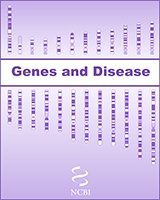NCBI Bookshelf. A service of the National Library of Medicine, National Institutes of Health.
National Center for Biotechnology Information (US). Genes and Disease [Internet]. Bethesda (MD): National Center for Biotechnology Information (US); 1998-.

Achondroplasia is a Greek word meaning "without cartilage formation" and is one of the most common causes of dwarfism. The appearance is of short stature with disproportionately short arms and legs and a large head. The characteristic facial features include a prominent forehead and a flattened bridge of the nose.
Although this condition can be inherited in an autosomal dominant manner, 80% of cases are due to new, sporadic mutations. Mutations involve the gene encoding fibroblast growth factor receptor 3 (FGFR3), situated on chromosome 4. Most commonly, a point mutation causes the substitution of arginine for glycine (G380R) in the transmembrane region of the receptor.
There is growing evidence that mutations of FGF3R confer a "gain of function". It is proposed that the normal function of FGFR3 is to slow down the formation of bone by inhibiting the proliferation of chondrocytes, the cells that produce cartilage. The mutation increases the activity of FGFR3, severely limiting bone growth.
This theory is supported by the knock-out mouse model in which the receptor is absent, and so the negative regulation of bone formation is lost. The result is a mouse with excessively long bones and elongated vertebrae, resulting in a long tail. Achondroplastic mouse models are useful tools in developing potential treatments.
Related diseases
- Genome view see gene locations
- Entrez Gene collection of gene-related information
- BLink related sequences in different organisms
- Research articles online full text
- Books online books section
- OMIM catalog of human genes and disorders
- GeneReviews a medical genetics resource
- Achondroplasia - Genes and DiseaseAchondroplasia - Genes and Disease
Your browsing activity is empty.
Activity recording is turned off.
See more...
